A Private Tour today down in the Brecks. It was a lovely bright, sunny start to the day, although it clouded over late morning, a few hours earlier than forecast. With some restrictions on our mobility we would have a slightly different itinerary today, but we would still be aiming to see as many of the key Brecks species as possible.
To start the day, we headed into the Forest and took a short walk along a ride to look for Woodlarks. As we made our way down the track and out into the clearing, there were lots of finches flying back and forth overhead, up to feed in the pines and down towards the river to drink, Bramblings, Chaffinches and Siskin. One or two of the Bramblings were singing – not much of a song, more of a wheeze! They weren’t sitting still, but we eventually got one of the males in the scope long enough to get a proper look at it.
While we were looking at the finches, two larger birds flew in past us, their distinctive broad wings and short tails identifying them as a pair of Woodlarks. They dropped down to the ground by the track back the way we had just come, and we walked back a short way to get a closer look at them. We could only see one now, presumably the male, perched on a clod of earth, preening. We could see its short crest, rusty cheeks and prominent supercilium, the two sides meeting in a shallow ‘v’ on the back of the neck.
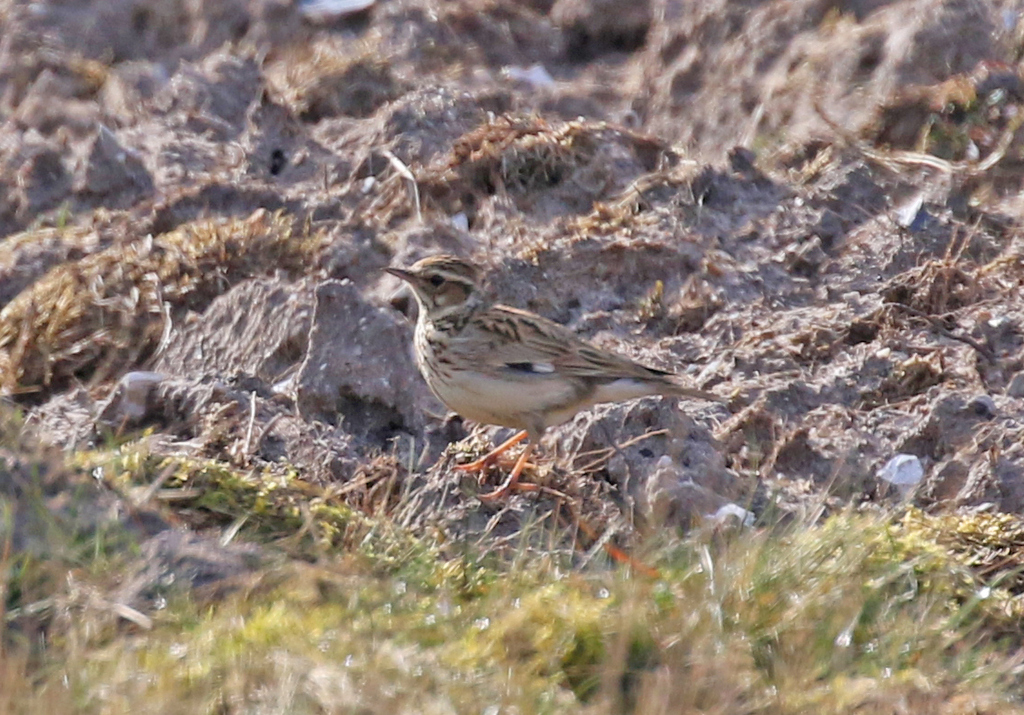
The Woodlark started to pick around in the bare earth and the walked further off into the grass beyond. Then it flew up into a small oak tree at the back of the clearing, where it perched silently and we got some more great views of it through the scope. There was no sign of the second bird now.
We heard a woodpecker drumming from somewhere beyond the clearing and listening carefully the sustained rapid bursts told us it was a Lesser Spotted Woodpecker. We shifted our position to try to triangulate the sound and it seemed to be coming from somewhere over by the road. We couldn’t get easily round there on foot, so we decided to walk back to the van and drive down. Unfortunately, despite it having been drumming on and off for several minutes when we were in the clearing, it had gone quiet by the time we got to where we thought it might have been. Another Brambling was feeding on the buds of a willow by the road.
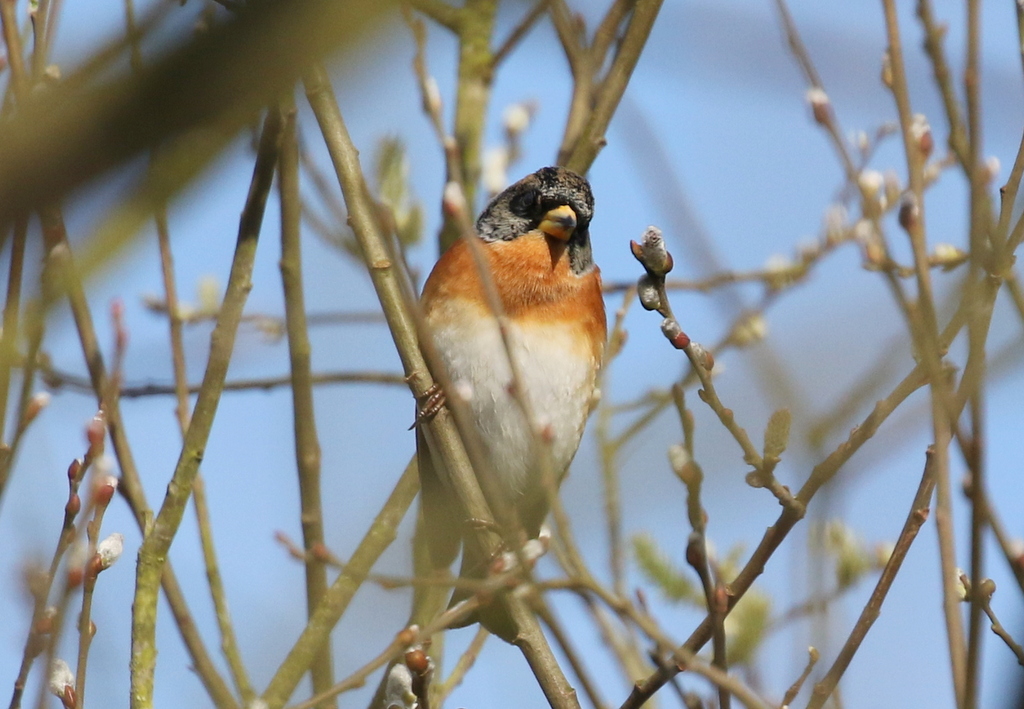
There has been a Rough-legged Buzzard at Weeting Heath for the last few weeks, so we headed over there next to see if we could catch up with it, and the Stone Curlews. We stopped first at the field entrance just before the reserve to look for the buzzard – it has been favouring the trees beyond here. There was already somebody here looking and we were told it had just flown round to the back of one of the trees, and landed out of view.
There was a nice male Wheatear out on the short grass in the field away to the left though – a bit distant, but a nice spring migrant to catch up with here. A Blackcap was singing in the trees behind us too, another returning migrant and always nice to hear. With Skylarks singing too, it almost felt like spring! Two (Eurasian) Curlews were feeding in the winter wheat field out in front of the gate.
It was starting to warm up a bit now and we could see several Common Buzzards circling up above the trees. While we scanned the sky for raptors, just in case the Rough-legged Buzzard might have taken off while no one was looking, we noticed a different bird of prey rising into the sky. It was a Goshawk, a juvenile, and it started to display, flapping with deep, exaggerated wingbeats.
Another Goshawk circled up just below it, this time an adult, silvery grey above and almost white below, and it gave a few deep, slow wing flaps too. Presumably this was designed to see off the youngster, as the two birds then drifted off in different directions. Goshawk was one of our target birds for the day, but not one we had expected to get here, so this was another bonus! It didn’t look like the Rough-legged Buzzard was going to reappear in a hurry, so we decided to go and try our luck with Stone Curlews and have another look for it later.
When we got to the Visitor Centre, we were told that the Stone Curlews were not showing from the hide today, but there were two in the field across the road. Looking across from the path just beyond West Hide, we were quickly put on to one of them. It was sat down in the grass, which made it hard to see, not helped by the heat haze which was already starting to develop – a perennial problem here, despite it being early in the morning on a cool March day!
Scanning the grass, we eventually managed to find the second Stone Curlew. It was much easier to see as it was standing up and it ran over towards the first in a series of bursts. Its yellow legs really stood out in the spring sunshine! We then realised we could see the Rough-legged Buzzard from here too, perched on the back of the tree where it had disappeared to earlier. It was rather distant, but through the scope we could see its pale head and contrasting black belly patch.
We had a quick look from West Hide, just in case. There was a Lapwing and a single Curlew out in the long grass, but as we had been informed, no sign of any Stone Curlews from here today. So we headed back to the Visitor Centre for a coffee break.
While the group was having coffee, a quick look across the road revealed that the Rough-legged Buzzard had flown across and landed in the top of one of the pines opposite the reserve. Unfortunately, before we could all get back across to the gate it had flown again, back towards the trees where it had been earlier. We decided to drive down to the field entrance, as it was on our way, and see if it was on view and we hadn’t gone more than a few metres before we saw it perched on the corner of the pines.
From the gate, we had a great view of the Rough-legged Buzzard. It was perched back onto us at first, so we could see its white tail with a wide black bar towards the tip. Then it flapped and gave us a good flash of its wings and tail, before settling round the other way, face onto us. Well worth the extra stop for the much better views.

It clouded over now and the morning sunshine disappeared. We had planned to go looking for Goshawks next, thinking it would stay sunny until early afternoon at least, but it didn’t look so good for them now. At least we had already seen a couple of Goshawks this morning. Still, we drove over to a convenient spot overlooking the forest and stopped to scan over the trees.
There were a few Common Buzzards circling up and it didn’t take us long to find our first hawk. Unfortunately it was the wrong one – a Sparrowhawk. We could see it was small and rather dark, and when it started to flap it did so in rapid bursts. A short while later, another Sparrowhawk circled up the over on the other side.
It felt quite cool now, with a fresh NW wind, and we wondered whether we might have missed the main Goshawk activity in the sunshine earlier. Eventually a Goshawk appeared, circling away to our left. We got it in the scope and had a look at it before it drifted off over the trees and disappeared. We started to wonder whether that might be the lot.
There were other birds to see here though. A flock of Fieldfares flew in and landed in the trees behind us, tchacking. Then a pair of Mistle Thrushes flew out and across the field. There were Lapwings displaying and lots of Meadow Pipits down in the rough grass. We could hear one or two Skylarks singing and then a Woodlark started up away behind us too.
Finally another Goshawk came up over the trees in front of us. As it was turning in regular circles, we could get it in the scope and get a really good look at it – an adult, with pale grey upperparts and whitish below. We could see its broad, rounded tail. It gradually gained height, going higher and higher into the clouds. At one point, we had the Goshawk circling in the same view as a Red Kite, a couple of Buzzards and a Kestrel!
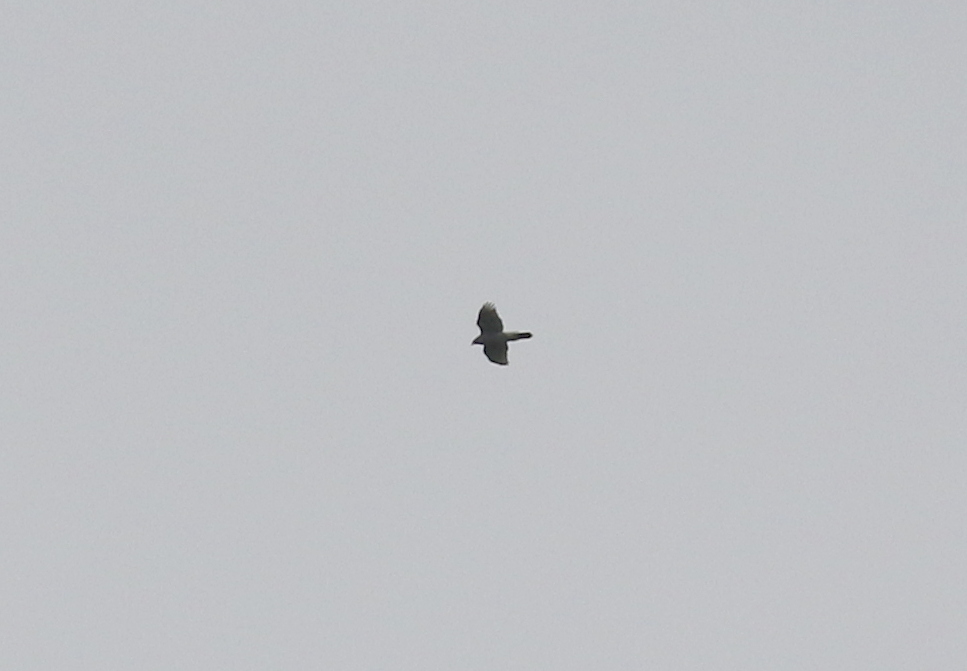
It didn’t look like it was going to do anything, but then the Goshawk did a quick burst of slow-flapping display and then swooped sharply down, before turning back up almost vertically and stalling at the top. Even one rollercoaster display was welcome, but after circling again for a minute or so, the Goshawk suddenly launched into a series of swoops. On the last one, it folded its wings and plunged straight back down into the trees. Great to watch!
That seemed a good signal to move on. We drove round to a couple of clearings to see if we could find any more Woodlarks singing next. On our way, we saw several Brown Hares in the fields. At the first clearing, we just listened from the van and all was quiet. But at the second clearing, as we drove up we could hear a Woodlark calling. We parked and got out and could see one perched in the top of a small oak tree by the path through the middle. We decided to have a short walk down the path for a closer look.
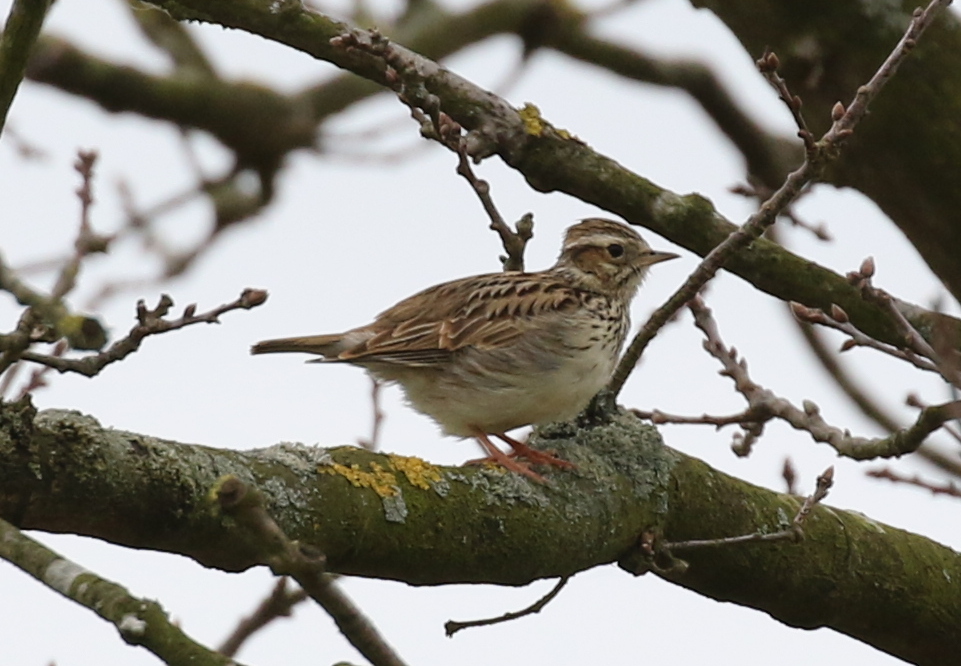
A second Woodlark flew up into the tree too, then dropped down to the long grass in the clearing below. From down along the path, we had a great view of the first, perched on a branch preening. It looked like it might sing at one point, fluttering out from the tree and round in front of us, but decided to land again. A Yellowhammer flew up into the top of the tree above. When the second Woodlark came up out of the clearing again, the pair flew off out into the middle together. We could still see them walking about in the grass between the rows of young trees.
The day was getting on now. We decided to drive back to Lynford Arboretum and make use of the picnic tables for a late lunch. As we stopped in the car park and got out, we could hear a Firecrest singing. We walked over to the trees and could see it high in the bare branches of a beech, but unfortunately it dropped back into the firs behind before everyone could get over to see it.
We could still hear it singing and thankfully the Firecrest then decided to fly back out into the open again. It perched in some bare branches in front of us singing and we could see its body shaking with the effort. We had a great look at it, before it flew back into the firs again. This was one of the other main targets for the day, so another mission accomplished. Then it was definitely time for lunch!

There were a few other birds in the trees above the picnic tables while we ate – one or two Goldcrests, several Coal Tits and a Siskin feeding on the opening pine cones. After lunch, we set off to explore the Arboretum. We still wanted to try to see Hawfinch and Crossbill this afternoon.
Stopping first at the gate, there were still a few Bramblings feeding down on the ground in the leaves under the trees. One smart male was really starting to get a black head now. It won’t be long before they are on their way back to Scandinavia for the breeding season. A couple of Yellowhammers flew down to feed on the seed too.
Most of the feeders on the trees were empty, but one or two still had food in and a succession of tits came in to look for something to eat. Then somebody noticed a Treecreeper on one of the feeders and we watched as it picked away at the compacted food in the bottom behind the mesh. Not something you see very often!
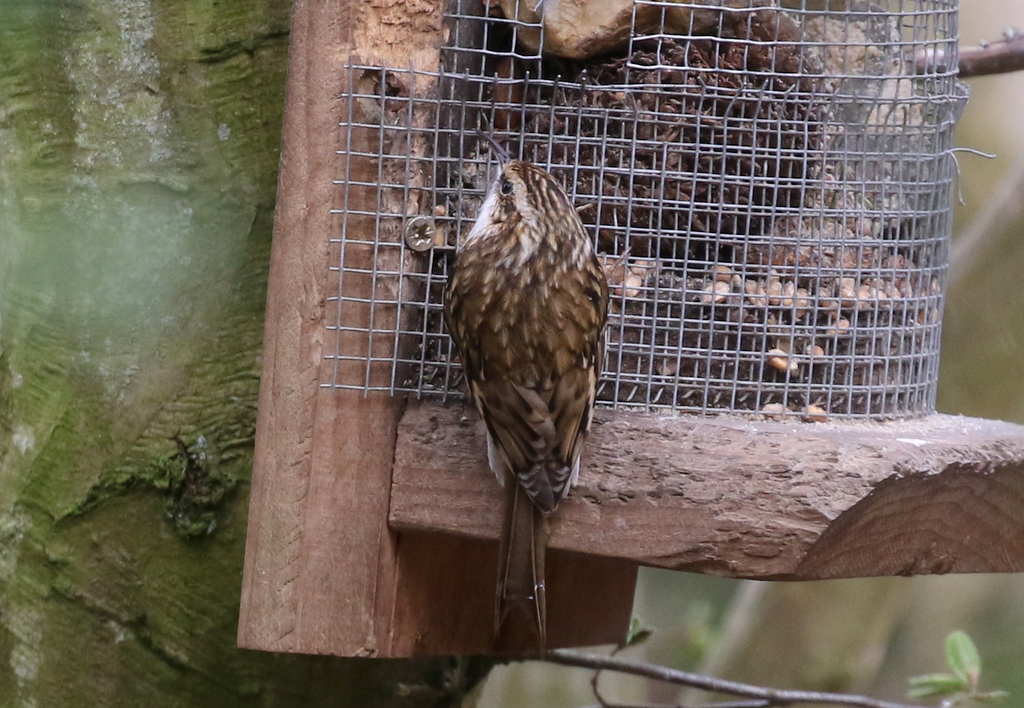
Continuing on, there were more Yellowhammers feeding at the hopper out in the orchard, which contains the food for the ducks and chickens. As we walked down past the meadow, we looked up at the pines at the back and noticed a bulky looking bird perched in the top of one. Through the scope, we could see it was a male Common Crossbill.
It took off and flew in towards us, ‘glipping’ loudly, and we could hear a second Crossbill answering from the trees on the edge of the Arboretum. When the first bird landed in the top of one of the trees, we could see there was a pair in the branches together. We were looking into the light from here, but we could see the distinctive crossed mandibles through the scope, before they flew off. Further back, on the edge of the Hall grounds, we could see lots of Fieldfares and Redwings in the tops of some more trees.
At the bottom of the hill, we stopped to look in the firs to see if the Tawny Owl was in its regular roosting spot. It was, but you had to be in just the right spot to see it, high up close to the trunk, half hidden in the branches.
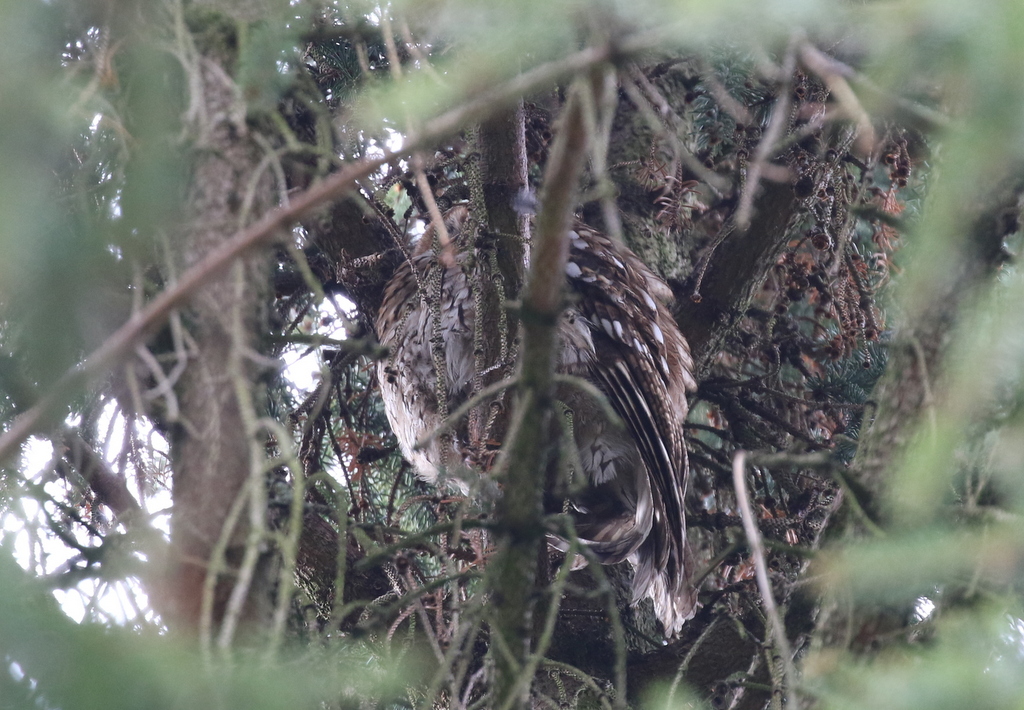
As we walked up over the bridge, we could see more Redwings and Fieldfares flying up into the tops of the poplars just beyond. A quick glance up and we noticed a slightly smaller bird in with them – a Hawfinch! We got it in the scope, but unfortunately it flew before everyone had a chance to look at it. We watched it drop down with the Redwings and disappear into the leafiest of the hornbeams in the paddocks.
We hurried on to the gap in the hedge overlooking the trees. We couldn’t see it at first, although we could hear it calling. Then another Hawfinch appeared in one of the other bare trees, again in amongst all the thrushes. Again, it was very flighty and dropped down before we could get the scope on it. Finally then one of the Hawfinches appeared in the bare branches of the same tree and this time stayed still a bit longer. Now, we could all get a good look at it, its thick neck and huge, cherry stone-cracking bill. It was calling and we could see its bill moving.
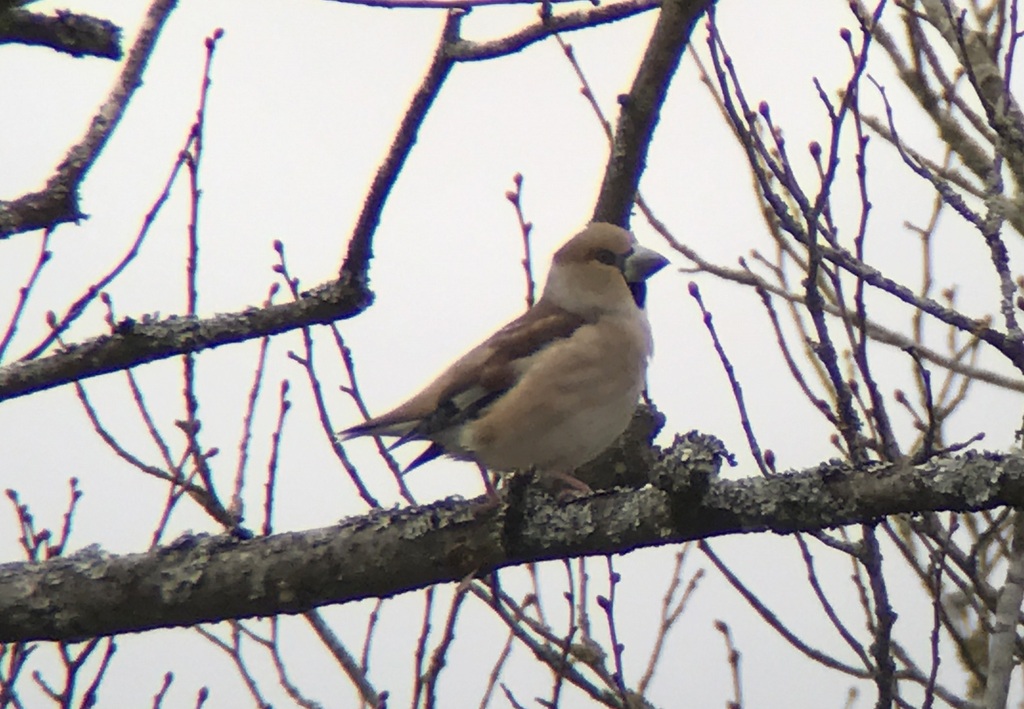
That Hawfinch then flew over and disappeared into the leafier tree too. At which point, a couple of people who had started to walk back towards the bridge called to us to say there were some Crossbills in the top of the poplars there. We walked back so we could see the tops of the trees and got the Crossbills in the scope. There were at least six of them, and they appeared to be mostly females but at least one redder male was with them.
When they started to drop down through the branches, we figured the Crossbills would be coming down to drink so we walked back and took the path into the trees. We could hear several of the Crossbills flying off from the tops of the trees as we arrived, but then we spotted two fly up ahead of us. They had probably been down to drink already and we had missed it, but thankfully they landed not too high in the trees where we could get them in the scope.

We stood and watched the Crossbills for a while. They flew over to a branch on the other side of the path, where they weren’t against the light and we could get a really good look at them. We watched them climbing about picking at the bark and then the two of them perched together preening for several minutes.
Eventually, the Crossbills disappeared into the branches and we walked back to the bridge. There was lots of activity here now, with a steady stream of birds coming down to the selection of food which had put out around the pillars and balustrades. A male Reed Bunting was feeding on the top of one of the pillars and the variety of tits included regular visits from at least one Marsh Tit. The Nuthatches were making the most of the peanuts put out today, coming in and out repeatedly, grabbing a nut each time and presumably stashing it somewhere in the trees to eat later.

As we stood on the bridge and looked down into the rushes below, we could just see a Water Rail moving around in the vegetation. It seemed to know we were watching and initially kept itself fairly well hidden. We knew where it was because we could see the rushes moving. Finally it got a bit bolder and showed itself a bit better, walking through some of the more open patches.
It was a nice way to end the day, watching the comings and goings at the bridge, but we were tired now after the exertions of the day and it was time to make our way slowly back up the hill. It had been a very successful day in the Brecks, with all our target species seen and seen well, and a lot more besides!
















